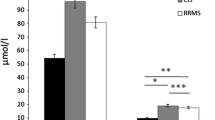Abstract.
Nitric oxide (NO) molecules have one of the most important roles in the pathogenesis of multiple sclerosis (MS). It has been stated that a continuous and high concentration of NO metabolites in CSF and in the serum of MS patients in relapse may cause toxic damage to myelin and oligodendroglia. The aim of this study was to investigate whether NO is a marker of disease activity and is correlated with other disease activity markers such as active lesions on brain magnetic resonance imaging (MRI) and increased immunoglobulin G (IgG) index.
Cerebrospinal fluid (CSF) and peripheral serum (PS) samples were taken from patients with definite MS (n = 24) during relapse and remission and from control subjects (n = 18). The Griess reaction was used to measure the NO metabolites, nitrite and nitrate in CSF and PS. Cranial MRI was carried out with triple dose (0,3 mmol/kg) gadolinium and the IgG index was determined.
Nitrite and nitrate concentrations (NNCs) of CSF were 11.16 ± 8.60 μmol/ml in relapse and 6.72 ± 3.50 μmol/ml in remission, whereas in PS they were 12.89 ± 7.62 μmol/ml during relapse and 12.35 ± 6.62 μmol/ml during remission. In control subjects NNCs in CSF and PS were 7.42 ± 2.81 μmol/ml and 4.37 ± 1.63 μmol/ml respectively. NNCs in CSF during relapse period were significantly higher than those of both remission phase and control subjects (p = 0.000). Although serum NNCs did not differ in relapse and remission, they were still higher than normal controls. Validity analysis revealed that NNC measurement in CSF was 71 % specific and 66 % sensitive to disease activity. The most important result was the significant correlation of increased NNCs with the existence of active lesion in cranial MRI and an increase in IgG index (p < 0.05).
In conclusion, these results add background data to assist in further outlining the possible role of NO in the pathogenesis of MS. Together with the other markers it may be used as an activity marker in relapses of MS.
Similar content being viewed by others
Author information
Authors and Affiliations
Additional information
Received: 29 August 2002, Received in revised form: 19 November 2002, Accepted: 26 November 2002
Correspondence to Göksemin Acar, M. D.
Rights and permissions
About this article
Cite this article
Acar, G., İdiman, F., İdiman, E. et al. Nitric oxide as an activity marker in multiple sclerosis. J Neurol 250, 588–592 (2003). https://doi.org/10.1007/s00415-003-1041-0
Issue Date:
DOI: https://doi.org/10.1007/s00415-003-1041-0




